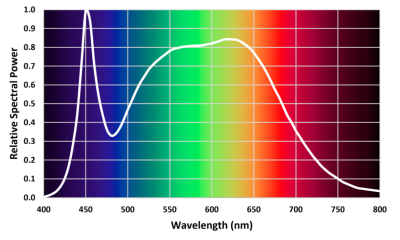Date: 06 Mar 2024
Light is made up of photons, which are tiny particles traveling at the speed of light. Photons in light beams vibrate at different frequencies and wavelengths. Humans can see photon emissions within wavelengths of 380-680 nm, while plant sensitivity to light ranges from 200-800 nm. Not all wavelengths within this spectrum have the same effect on photosynthesis; those that activate the biochemical processes in plants to the greatest extent are called PAR (photosynthetically active radiation), whose spectral range is 400-700 nm.
Light can be measured with photometric quantities derived from the sensitivity of the human eye to colors, or with radiometric quantities related to the energy carried by light rays. Lumens and lux are commonly used photometric units that refer to the light perceived by the human eye.
However, photometric measurements do not show how much light energy the lamp sends to the plant for photosynthesis because they do not include PAR variables. However, lumens and lux can give an initial idea of the power output of a particular bulb, and we can compare different products by measuring their photometric efficiency with the lumen : watt ratio, regardless of possible differences in the power of the light spectrum at different wavelengths.
Lux and lumens work well when measuring lights like MH, HPS, CFL, but will not accurately measure the efficiency of an LED grow light.
Generally speaking, the minimum amount of broad spectrum light that a tomato plant needs for example is about 9000lm per square meter, and the optimum is over 20,000lm/m². However, the growth and flowering of a vigorous houseplant depends on light thresholds reached at certain wavelengths that trigger photosynthesis. That's why LED grow lights use radiometric systems to measure the amount of photons emitted in the PAR color frequencies we mentioned earlier.
The most widely used radiometric measurement in horticulture is PPFD (photon flux density), which measures the flux of PAR photons in micromoles per second per square meter (μmol/m²/s). Assuming that the PPFD of a given grow light is provided, we can calculate its radiometric efficiency and compare different lighting systems using the PPFD:watt ratio.
SUN, BULBS AND APPROPRIATE PHOTON PRESSURE
The midsummer sun reaches Earth with a photosynthetic output of 1200-2000 PPFD. However, seedlings, clones and mother plants are satisfied with a PPFD of only 200-400μmol/m²/s. Tomato plants in their vegetative phase need 400-600μmol/m²/s and flowering plants usually need 600-1500μmol/m²/s PPFD.
A study found that the most productive PPFD for tomato is 1500-2000μmol/m²/s at 25-30 °C with natural CO₂ increased to 750 ppm.
Even if tomato is a fastidious plant, irradiance above the cut-off threshold for any cultivar, life stage or environmental condition does not necessarily increase yield. Conversely, excessive photon pressure can cause leaf and flower damage. In other words, flower production increases when the tomato receives 20-30 moles of PAR light per day, then levels off between 30-40 moles and decreases above 40 moles.
HOW MUCH LIGHT DOES YOUR GROW ROOM NEED?
To find the right amount of light for your crop, you need to multiply the length of the grow room by its width to get the grow area, then multiply the resulting figure by the desired PPFD level.
If your grow room is 250 cm long and 80 cm wide, the grow area will be 2.50 m × 0.80 m = 2m². If you are aiming for a flowering plant roof of around 2 sq m and want to experiment with a PPFD level of 500 μmol, you simply need 1000 μmol/m²/s. This result must then be divided by the PPFD for one watt of light to determine the required wattage.

 New products
New products 












































































 Presents
Presents













Post comment